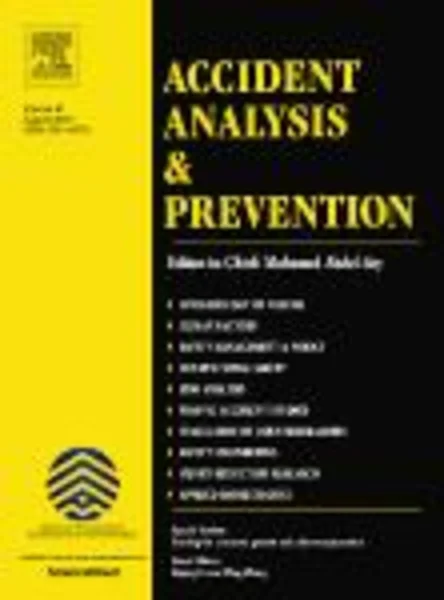-
a field evaluation of real-life motor vehicle accidents: presence of unrestrained objects and their association with distribution and severity of patient injuries
جزئیات بیشتر مقاله- تاریخ ارائه: 1392/01/01
- تاریخ انتشار در تی پی بین: 1392/01/01
- تعداد بازدید: 664
- تعداد پرسش و پاسخ ها: 0
- شماره تماس دبیرخانه رویداد: -
moving objects may pose an added threat to car occupants in motor vehicle accidents (mvas). however, to our knowledge, there have only been two case studies published on the subject. for the present study, accident reports and photo documentation from mvas were collected on-scene by dedicated paramedics. emergency medical service personnel on-scene were interviewed as necessary. potentially harmful unrestrained objects in the involved motor vehicles (mvs) were identified and categorised by type, weight and hardness. seatback offset by unrestrained objects was noted. the patient injury distribution (abbreviated injury scale (ais) body regions) and severity (ais severity scores and new injury severity score (niss) scores) were retrospectively determined from hospital and autopsy records, and their potential relationship to unrestrained objects was explored. a total of 190 accidents involving 338 mvs and 618 individuals were included. in total, 327 individuals (53%) were injured, and 61 (10%) died. 37 of 61 were not autopsied. the mean niss was 17 (median 8, interquartile range (iqr) 1–27). unrestrained objects were reported for 133 motor vehicles (39%) involving 293 individuals. 35% of the unrestrained objects found in the passenger compartment weighed >2 kg. in the boot, 32% of objects weighed >20 kg. seatback offset associated with unrestrained objects was found for 45 individuals (15%). unrestrained objects originally located in the boot (heavy luggage, groceries and tyres were the most frequently reported) had moved into the passenger compartment on impact in 27 cases, 24 of which were associated with seatback offset. an in-depth analysis was performed on 24 patients whose injuries were highly likely to be associated with unrestrained objects, as indicated by accident reports and medical documentation. nineteen (79%) were involved in frontal collisions, and 12 (50%) died on-scene. the mean niss was 51.7 (median 51, iqr 27–75) in the 17 (71%) patients with seatback offset and 37.2 (median 41, iqr 22.5–50) in the 7 (29%) without seatback offset. seatback offset was associated with more severe head and thoracic injuries and an increased incidence of abdominal and pelvic injuries. patients injured by unrestrained objects while sitting in unharmed car seats predominantly suffered head, cervical spine and thoracic injuries. our results indicate a need for public information campaigns. the development of car backseats that can better sustain hits from heavy objects in the cargo boot is an important area for the motor vehicle production industry to explore.
مقالات جدیدترین رویدادها
-
استفاده از تحلیل اهمیت-عملکرد در ارائه الگوی مدیریت خلاقیت سازمانی و ارائه راهکار جهت بهبود
-
بررسی تاثیر ارزش وجوه نقد مازاد بر ساختار سرمایه شرکت های پذیرفته شده در بورس اوراق بهادار تهران
-
بررسی تأثیر سطح افشای ریسک بر قرارداد بدهی شرکت های پذیرفته شده در بورس اوراق بهادار تهران
-
بررسی تأثیر رتبه بندی اعتباری مبتنی بر مدل امتیاز بازار نوظهور بر نقد شوندگی سهام با تأکید بر خصوصی سازی شرکت ها
-
تأثیر آمیخته بازاریابی پوشاک ایرانی بر تصویر ذهنی مشتری پوشاک ایرانی (هاکوپیان)
-
بررسی تاثیر آرماتور طولی و عرضی بر رفتار ستون های بتن آرمه تحت بارگذاری انفجاری
-
بررسی آثار ابعاد معماری سازمانی بر فرهنگ سازمانی کتابداران کتابخانه های دانشگاهی (رازی و علوم پزشکی کرمانشاه)
-
بررسی رفتار لرزه ای و ضریب رفتار گنبدهای دو لایه فضاکار
-
بررسی ارتباط بین سلامت مالی و فرصت های سرمایه گذاری در شرکتهای پذیرفته شده در بورس اوراق بهادار تهران
-
بهینه یابی شکل سدهای بتنی دو قوسی براساس تحلیل دینامیکی با در نظر گرفتن اندرکنش سد و مخزن با استفاده از الگوریتم ژنتیک
مقالات جدیدترین ژورنال ها
-
مدیریت و بررسی افسردگی دانش آموزان دختر مقطع متوسطه دوم در دروان کرونا در شهرستان دزفول
-
مدیریت و بررسی خرد سیاسی در اندیشه ی فردوسی در ادب ایران
-
واکاوی و مدیریت توصیفی قلمدان(جاکلیدی)ضریح در موزه آستان قدس رضوی
-
بررسی تاثیر خلاقیت، دانش و انگیزه کارکنان بر پیشنهادات نوآورانه کارکنان ( مورد مطالعه: هتل های 3 و 4 ستاره استان کرمان)
-
بررسی تاثیر کیفیت سیستم های اطلاعاتی بر تصمیم گیری موفق در شرکتهای تولیدی استان اصفهان (مورد مطالعه: مدیران شرکتهای تولیدی استان اصفهان)
-
ارزیابی تاثیر کارکردهای اطلاع رسانی، آموزشی و همبستگی فضای مجازی بر ترویج فرهنگ محیط زیستی مطالعه موردی: سازمان های مردم نهاد فعال در حوزه محیط زیست
-
سنجش کارائی فعلی و راهکار ارتقاء کارآمدی آتی مرحله امکان سنجی در پروژه های ساختمانی
-
مدیریت در علوم ورزشی و تربیتی، لازمه تحقق جهش تولید
-
estimation of origin – destination matrix from traffic counts based on fuzzy logic
-
designing manhole in water transmission lines using flow3d numerical model




سوال خود را در مورد این مقاله مطرح نمایید :